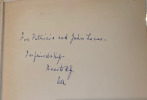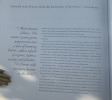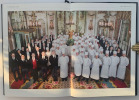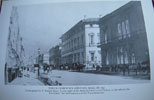Aromas and Flavors of Past and Present.
PRESENT (small printer's device) Alice B. Toklas WITH INTRODUCTION AND COMMENTS BY POPPY CANNON (small printer's device) HARPER & BROTHERS PUBLISHERS, NEW YORK
FIRST EDITION. 1958. 215x145 mm 1fep with signed inscription " For Patricio and John Lucas - In friendship - Beautifully Alice". [1] Half-title. [1] Title page. Verso with K-H to printer's details. 1p Contents. [1] vii-xxiii Introduction by Poppy Cannon. [1] xxv-xxvi Preface. Another Half-title. [1] 1-160 161-164 Index. 1fep. Near fine D/J with 1x5mm small chip. Price-clipped. Quarter red cloth spine with gilt lettering. Blue paper covers. On the bottom of the front inside cover under the d/j is a tipped-in simple book-plate of JOHN S. LUCAS. Text block as new.
- Toklas's 'Aromas and Flavors' was her second cookbook following the huge popularity of her 'Cook Book' pub: 1954. (see item # 11098 above). In Poppy Cannon's introduction, she describes the rich years of Toklas's and Gertrude Stein's close relationship as one in which Miss Stein wrote and talked, while Miss Toklas cooked and talked. It appears, by Toklas's output of two cookery books, that she also inherited some of Stein's skills. She is also praised by Cannon for being steeped in the traditions of classic French cuisine and a great respect for seventeenth-century gastronomy. A scan of the recipes throws up some unusual dishes: An intriguing Ham & Oyster pie, a diet defying Sweetbread Salad, a humble Sauerkraut with Pig's Trotter, a Duck with Delicate Aspic to be served in candlelight, possibly with Cabbage Pancakes to accompany. One other recipe to catch the eye is Puff Pastry made with Olive Oil instead of butter. One gets a sense of a very serious cook who does a lot of research and is attracted to eccentric dishes. One can imagine the constant company of great artists such as Picasso, Matisse et al, that she and Gertrude Stein regularly entertained, in whom the norm is anything but; therefore one sees in her interesting and unusual cook book the gastronomic norm that the eccentric but creative Toklas embraces. No other recipe in her book personifies this but the "Kidneys in Champagne'. Recommended firstly to use pig or veal kidneys, but failing this, instead of purchasing the nicer tasting Lamb kidneys she recommends Chicken Livers. One can see the influence of early French cuisine that one senses Toklas had a great respect for and she seriously tries to offer this in her cook book. A noble effort. This is initially a very scarce Toklas 2nd title made rare, as no other signed copy has been traced nor appeared in auction.





click on image to enlarge

Modern category
ref number:
11335 










